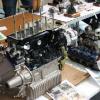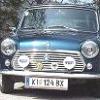You guys have touched on many areas where I would like to offer comments and suggestions. Sorry for the long post.
Carvell, the nature of your first post suggests to me that you are undertaking a bunch of DIY projects for pieces and parts. While you can collect all those parts and have them media blasted and then professionally coated that may get expensive. You can do a lot of prep work at home and even some of the coatings. That can save you money and sometimes... time.
General Cleaning:
Always start by removing loose paint, oil, and grease. Start with grease removal. Strong caustic cleaners work well on grease and oil. A DIY chemical would be something like a strong spray oven cleaner... except you must not use oven cleaner on aluminum. Wipe excess grease and oil off, spray the cleaner on, allow it to work for a while and scrub it into the surface using a parts cleaning brush. Wear gloves and eye protection. Rinse the oven cleaner off and follow with more traditional liquid degreasers/detergents. With the grease and oil off the surface you can decide how much additional cleaning you want to do. Paint removal, particularly on castings is often best handled at home using chemical paint strippers... unless you have an air compressor and want to use a "blast out of the bucket" sandblaster.
Rust Removal:
There are several options. Always start with the cleaning above so you know the extent of what you are dealing with. Your choices for DIY rust removal are limited by your resources and how loudly your neighbors complain.
Sandblasting at home can work but you obviously have to have the equipment for it. It's not pleasant work. If I choose sandblasting I wait until I have a bunch of parts so I can get set up and do them all at once.
Electrolysis is a method that can work also if you have a few basic supplies. For complete details, Google "Electrolysis rust removal". In this process the cleaned part is placed in a solution of washing soda and water. The steel part is connected to the negative side of a car battery charger and the positive is connected to a sacrificial piece of steel. The current flowing through the electrolyte will boil off a number of surface contaminants and rust. Some secondary cleaning will be required and it is difficult to get the inside of cavities 100% using this process. However, once set up, you can leave this process going on its own which will free you for other tasks. For the amount of effort involved, this method works VERY well on large parts.
Chemical rust treatment is also possible at home. Look for phosphoric acid at your local industrial or agricultural supply firm. Yes, it's acid, but it is NOT super dangerous. Like vinegar, phosphoric acid is an ingredient of many food products. In stronger concentrations it is very effective at removing rust from steel. The cleaned part is simply placed in a solution of the acid and allowed to soak. Check the part periodically and use a wire brush to scrub the thicker rust deposits. Surface rust is easily and quickly removed while deep/thick rust will require time. Do not let the acid dry on the surface. Rinse it off with clean water then wipe/blow dry to leave an iron phosphate coating behind... which is a great anchor for primer.
Conversion coatings... you will see a lot about coatings that you brush on, let dry, then paint over them. I am not a fan of those products. They may work for some but I have not had acceptable results from them (over long periods).
Painting:
Powder coat is wonderful on a properly prepared surface. However, to be cost effective you will need to gather a lot of parts so you are able to get them all done with one "lot charge". Taking individual parts to a painter one at a time can get very expensive.
I do like POR-15 and it is brushable. It should be available to you through Frost in the U.K. HOWEVER, POR is NOT something that is quick, nor (in my experience) is it perfect and trouble free. In all painting, prep work is key to good results. With POR this is even more true. You must acid etch the surface well for good adhesion. POR does much better at adhering to and protecting a surface that was rusty and treated than it does sound, smooth metal. Properly applied, POR will adhere well, however, it is so glassy smooth that almost nothing sticks to it. They have formulated some special POR primers for top coats but I have not tried their latest formulations so I cannot comment on them. I can tell you from my experience that you WILL get good results if after you have applied your second coat of POR you apply a FOG COAT (not a continuous coat) of the primer (for your brand of top coat) when the POR is not fully cured but reaches the state of being just slightly tacky to the touch. A full coat of primer at this point will seal in solvent fumes and cause paint blisters. Wait longer to apply the primer and the primer will not stick. It's tricky.
You do NOT have to top coat POR. Yes, it is UV sensitive. However, the sensitivity relates to the color pigments, not the strength and durability of the paint. POR will discolor, not fail if left uncoated. POR is available (to the best of my knowledge) in black, silver, grey, and clear. Since POR has a short shelf life once opened, I buy it in the more expensive small 1/2 pint cans in different colors. I typically apply the first coat in one color and the second (final) coat in a contrasting color so I can make sure I have 100% coverage.
Hammerite paint is good paint. However, I have found it to be more fragile than POR. That said, Hammerite is much less expensive and requires much less surface preparation than POR.
Again, with all painting, good results are possible only with proper preparation. Regardless of what paint you choose for the top, spend the effort and time to really clean and prepare the surfaces. If your paint maker has specific surface preparation steps listed for their product, be SURE to follow their recommendations.



















